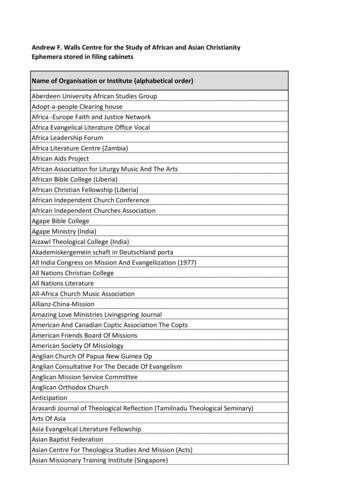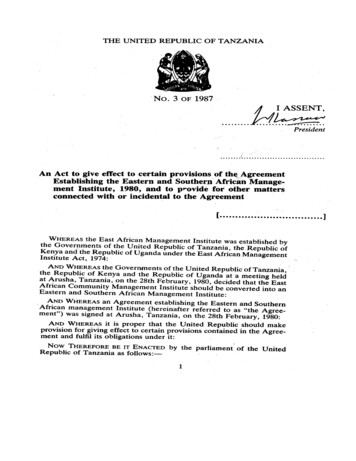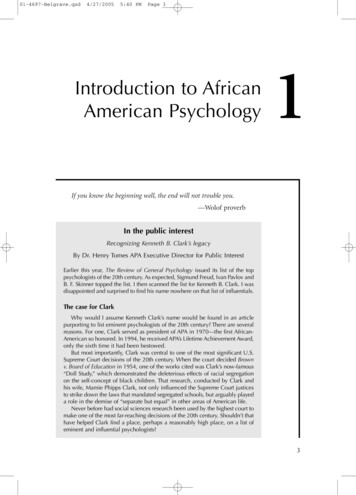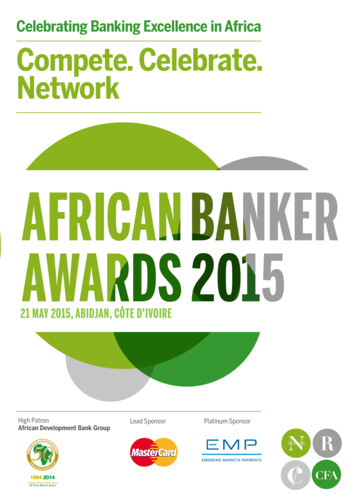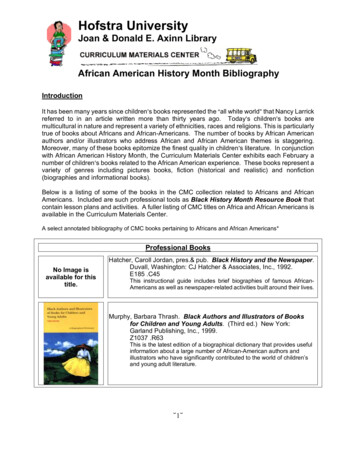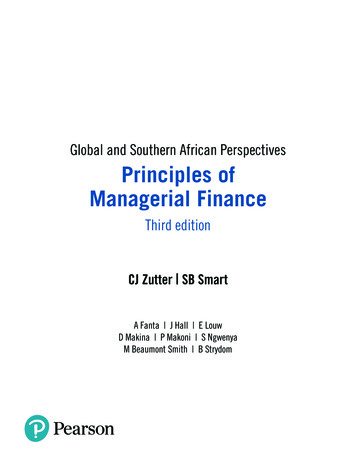
Transcription
Global and Southern African PerspectivesPrinciples ofManagerial FinanceThird editionCJ Zutter SB SmartA Fanta J Hall E LouwD Makina P Makoni S NgwenyaM Beaumont Smith B Strydom
Pearson South Africa (Pty) Ltd4th Floor, Auto Atlantic Building,Corner Hertzog Boulevard and Heerengracht,Cape Town, 8000Authorised adaptation from the US edition, entitled Principles of Managerial Finance,15th edition, ISBN: 9780134476315 by CJ Zutter and SB Smart publishedby Pearson Education, Inc, Copyright 2018.African edition published by Pearson South Africa (Pty) Ltd Copyright 2022.To request permission to reproduce or adapt any part of this publication,please visit .htmlISBN: 978-1-485-70919-0 (print)ISBN: 978-1-485-71887-1 (ePDF)Publisher: Aamina GangatSenior Managing Editor: Ulla SchulerEditor: Alco MeyerProofreader:Indexer: Lois HendersonBook and cover design: Pearson Media HubCover artwork: konstanttin.123rf.comArtwork: Claudia EckardTypesetting: Stacey GibsonAcknowledgements
BRIEF CONTENTSPrefacexviAbout the authorsxviiHow to use this bookxixPART 1: Introduction tomanagerial financeChapter 1 The role of managerial finance2Chapter 2 The financial market environment 27Integrative Case study 1:Lewanika Enterprises44PART 2: Financial toolsChapter 3 Financial statements and analysis 46Chapter 4 Long and short-term financialplanning101Chapter 5 Time value of money146Integrative Case study 2:Efficient Software Ltd211PART 3: Valuation of securitiesChapter 6 Interest rates and bond valuation 216Chapter 7 Share valuation258Integrative Case study 3: PerformacAutomotive International302PART 4: Risk and therequired rate of returnChapter 8 Risk and returnChapter 9 The cost of capital304352Integrative Case study 4:Eskimo Cooling’s green airconditioners388PART 5: Long-terminvestment decisionsChapter 10 Capital budgeting techniquesChapter 11 Capital budgeting cash flowsChapter 12 Risk and refinements incapital budgetingIntegrative Case study 5: UniMiningManufacturing Company390427464503PART 6: Long-termfinancial decisionsChapter 13 Leverage and capital structure 506Chapter 14 Payout policy555Integrative Case study 6:Co-operative Wine Merchants586PART 7: Short-term financialdecisionsChapter 15 Working capital and currentassets management590Chapter 16 Current liabilities management 629Integrative Case study 7:Superior Outdoor Plastics661PART 8: Special topics inmanagerial financeChapter 17 Hybrid and derivative securitiesChapter 18 Mergers, LBOs, divestituresand business failureChapter 19 International managerial financeIntegrative Case study 8: OrganicSolutions664783AppendicesAFinancial tablesBSolutions to self-test problemsCAnswers to selected end-of-chapterproblemsGlossary837Index855703745
ivDETAILED TABLE OF CONTENTSPART 1: Introduction tomanagerial financeProblems24Spreadsheet exercise25Chapter 1 The role of managerialfinanceChapter 1 Case study: Management1.11.21.32remuneration and financial performanceof JSE firms3Finance and the firm5What is finance?5Career opportunities in finance6Legal forms of business organisation6Why study managerial finance?8Review questions9Goal of the firm10Maximise shareholder wealth10Maximise profit11Financial marketsWhat about stakeholders?13The relationship between institutionsThe role of business ethics13Focus on ethics14The money market31Review questions14The capital market32Focus on ethics14Focus on Practice33Managerial finance function14Review questions35Organisation of the finance function15Focus on Ethics35Relationship to economics15Financial risks and bank failures35Relationship to accounting16Credit risk36Counterparty credit risk3617Market risk36Review questions18Operational risk36Governance and agency18Interest rate risk37Corporate governance18Liquidity risk37The agency issue19Review questions37Review questions21Chapter 2 The financial 2Self-test problems22Warm-up exercises2327The regulation and supervision ofSouth African banks2.128Financial institutions and markets29Financial institutions29Commercial banks, investment banksand the shadow banking systemand markets2.2Primary activities of the financial1.426Corporate governance woes at Eskom2.3293031Regulation of financial institutionsand markets37Regulations governing the financialsector in South AfricaReview questions3839
Detailed table of contentsvSummary39Total asset turnover63Opener-in-review41Review question64Self-test problem41Debt ratios64Warm-up exercises41Debt ratio65Times interest earned ratio66Advanced problems41Review questions66Spreadsheet exercise42Profitability ratios663.53.6Common-size statements ofChapter 2 Case study: The pros and consof being publicly listedcomprehensive income4366Gross profit margin67Operating profit margin68Net profit margin68PART 2: Financial toolsEarnings per share (EPS)68Return on total assets (ROA)69Chapter 3 Financial statementsand analysisReturn on ordinary shareholder’sIntegrative Case study 1:Lewanika Enterprises3.14146equity (ROE)69Leopard Clothing Company47Review questions70The shareholders’ report48Market ratios70Global focus48Price/earnings (P/E) ratio70The letter to shareholders49Market/book (M/B) ratio70Review question713.7The International AccountingStandard (IAS) and the four keyA complete ratio analysis7149Summarising all ratios71Focus on ethics50DuPont system of analysis75Notes to the financial statements56Applying the DuPont system76Review questions57Review questions76Using financial ratios57Interested parties57Types of ratio comparisons57Cautions about using ratio analysisfinancial 9Self-test problems78Categories of financial ratios60Warm-up exercises79Review questions60Problems80Liquidity ratios60Current ratio60Chapter 3 Case study: Assessing GlobalQuick (acid-test) ratio61Review question61Activity ratios62Inventory turnover62Average collection period62Average payment period63Manufacturing Company’s currentfinancial position97Spreadsheet exercise98Group exercise100
viDetailed table of contentsChapter 4 Long and short-termfinancial planning101Not streaming at Netflix – cash flow 1024.1The financial planning process103Long-term (strategic) financial plans103Short-term (operating) financial plans 1034.2Review questions104Measuring the firm’s cash flow105Depreciation105Depreciation methods106Developing the statement of cash flows 1074.3Interpreting the statement110Free cash flow112Focus on ethics112Focus on practice114Review questions114Cash planning: cash budget115The sales forecast115Preparing the cash budget115Evaluating the cash budget120Self-test problems130Warm-up exercises131Problems132Spreadsheet exercise144Chapter 4 Case study: Preparing ProtectU’spro forma financial statementsChapter 5 Time value of money5.15.24.4121Review questions1224.5Review question1245.34.7Computational tools150Basic patterns of cash flow152Review questions153Single amounts153Future value of a single amount153157158future value160Review questions161Annuities161Types of annuities161Finding the future value of anordinary annuity162Finding the present value of anordinary annuity164Finding the future value of an124annuity dueConsidering types of costs4.6149Comparing present value andPreparing the pro forma statement ofcomprehensive incomeFuture value versus present valuePresent value of a single amountPreceding year’s financial statements 122122149simple interestProfit planning: pro forma statements 122Sales forecastThe role of time value in financeCompound interest versus120Cash flow within the month146The reality of South Africa’s retirees 147Coping with uncertainty in thecash budget145166Finding the present value of anand expenses124Review questions125annuity due168Finding the present value ofPreparing the pro forma statement ofa perpetuity169Review questions170Mixed streams170financial position126Review questions128Evaluation of pro forma statements128Future value of a mixed stream170Review questions128Present value of a mixed stream172Review question174Summary128Opener-in-review1305.4
Detailed table of contents5.5Compounding interest moreFocus on practicefrequently than annually174Semi-annual compounding174Quarterly compounding175Monthly compounding175A general equation for compoundingmore frequently than annuallycharacteristics6.2Using computational tools forcompounding more frequentlyContinuous compoundingReview questions227Government and corporate bonds227Legal aspects of corporate bonds228Cost of bonds to the issuer229General features of a bond issue229Bond yields230Bond prices230177Bond ratings231Focus on ethics232178Common types of bonds232Review questions179International bond issues234Focus on ethics179Review questions234Valuation fundamentals valuation234of interestSpecial applications of the time value 180Determining deposits needed to6.3Key inputs235180Basic valuation model236Loan amortisation181Review questions236Finding interest or growth rates183Focus on practice183Bond valuation237Bond fundamentals237Bond valuation237accumulate a future sum6.4Finding an unknown number of periods 186Summary187Opener-in-review190Self-test problems190Warm-up exercises191Problems192Advanced problems207Chapter 5 Case study: Funding LeonardChaba’s retirement annuity210Integrative Case study 2: EfficientSoftware Ltd211PART 3: Valuation of securitiesChapter 6 Interest rates and bondvaluation6.1226176Nominal and effective annual rates5.6223Risk premiums: issuer and issue176than annuallyviiSemi-annual interest rates andbond values238Changes in bond values240Yield to maturity (YTM)243Review questions244Summary244Opener-in-review246Self-test problems246Warm-up exercises247Problems248Spreadsheet exercise256Chapter 6 Case study: Evaluating MarleneMashiymbe’s proposed investment in216Eskom bonds217Interest rates and required returns218Interest rate fundamentals218Term structure of interest rates222Aluta Industries’ bondsChapter 7 Share valuationVodacom: Initial public offering7.1257258259Differences between debt andequity capital260
viii7.27.3Detailed table of contentsVoice in management260Claims on income and assets260Maturity261Tax treatment261Review question261Ordinary and preference share capital 261PART 4: Risk and the requiredrate of returnChapter 8 Risk and return8.1Risk management at Remgro Ltd305Risk and return fundamentals307Ordinary share capital261Risk defined307Preference share capital264Return defined308Interpreting share quotations271Focus on ethics309Review questions273Risk preferences311Ordinary share valuation273Review questions312Risk of a single asset312Risk assessment312275Risk measurement313275Review questions318Risk of a portfolio318Market efficiency and stock valuation 2738.2Ordinary share dividendvaluation modelFocus on practiceFree cash flow share valuation model 2808.3Other approaches to ordinaryshare valuation7.4304Portfolio return and standard deviation 318282Correlation319Focus on ethics283Diversification320Review questions285Correlation, diversification, riskand returnDecision-making and ordinary321share value285International diversification323Changes in expected dividends286Global focus324Changes in risk286Review questions325Combined effect287Review questions287pricing model (CAPM)325Summary287Types of risk325Opener-in-review290The model: CAPM326Self-test problems290Review questions334Warm-up exercises291Problems292Advanced problems299Chapter 7 Case study: Assessing theimpact of Babeca Wholesalers’proposed risky investment on its share301Risk and return: The capital assetSummary334Opener-in-review336Self-test problems336Warm-up exercises337Problems338Advanced problem349Chapter 8 Case study: Analysing risk andIntegrative Case study 3: PerformacAutomotive International8.4302return on Booster Products’ investments 350Spreadsheet exercise351
Detailed table of contentsChapter 9 The cost of capital9.19.29.3352Self-test problem374Growthpoint Properties Ltd353Warm-up exercises376Overview of the cost of capital354Problems376Some key assumptions354The basic concept354Advanced problem384Focus on ethics355Specific sources of capital356Review questions356Spreadsheet exerciseCost of long-term debt356Integrative Case study 4: Eskimo Cooling’sNet proceeds357The before-tax cost of debt357The after-tax cost of debt359Review questions359Cost of a preference share359Preference share dividends359Calculating the cost of apreference share9.4360Review question360Cost of an ordinary share360Finding the cost of ordinaryshare equityCost of retained earnings360362Cost of new issues of ordinary shares 3639.5Review questions364Weighted average cost of capital364Calculating weighted average cost of9.6ixcapital (WACC)364Weighting schemes365Review questions367Marginal cost andinvestment decisions367The weighted marginal cost ofcapital (WMCC)367Focus on practice368Investment opportunities schedule (IOS) 370Using the WMCC and IOS to makefinancing/investment decisionsReview r 9 Case study: Making Tackle Bob’sfinancing/investment decisiongreen air conditioners385386388PART 5: Long-term investmentdecisionsChapter 10 Capital budgetingtechniques390The gold standard for evaluatinggold mines10.1 Overview of capital budgeting391392Motives for capital expenditure392Steps in the process392Basic terminology393Benonxi Company’s relevant cash flows 394Review question39510.2 Payback period395Decision criteria395Pros and cons of payback periods396Focus on practice397Review questions39910.3 Net present value (NPV)399Decision criteria399NPV and the profitability index (PI)401NPV and Economic Value Added401Review questions40210.4 Internal rate of return (IRR)403Decision criteria403Calculating the IRR403Review questions40510.5 Comparing NPV and IRR techniques405Net present value profiles405Conflicting rankings407
xDetailed table of contentsWhich approach is better?409After-tax proceeds from sale of old asset 443Review questions410Change in net working capital443Focus on ethics410Review question44411.5 Summarising the relevant cash flows 445Summary411Opener-in-review413Self-test problem413Summary446Warm-up t problems448Advanced problems423Warm-up exercises448Problems449425Advanced problems459426Chapter 11 Case study: DevelopingChapter 10 Case study: Making Clean Air’snew ventilator investment decisionSpreadsheet exerciseChapter 11 Capital budgetingcash flowsSASOL11.1 Relevant project cash flows427428429429Focus on ethics430430431International capital budgetingand long-term investments432Review questions433Global focus43311.2 Finding the initial investmentInstalled cost of new asset434435After-tax proceeds from sale ofold asset435Change in net working capital437Calculating the initial investment438Review questions43911.3 Finding the operating cash inflows439Interpreting the term cash inflows439Interpreting the term after-tax440Interpreting the term incremental441Review questions44211.4 Finding the terminal cash flowProceeds from sale of assetsCompany’s machine renewal orreplacement decisionSpreadsheet exercise443443462463Chapter 12 Risk and refinements incapital budgeting464MTN’s Nigerian experienceExpansion versus replacementSunk costs and opportunity costs446relevant cash flows for Everest PublishingMajor cash flow componentsdecisionsReview question46512.1 Introduction to risk in capitalbudgeting466Review question46612.2 Behavioural approaches for dealingwith risk466Break-even analysis466Scenario analysis468Simulation469Focus on practice470Review questions47012.3 International risk considerations470Adjusting for currency risk471Review question47112.4 Risk-adjusted discount rates472Determining risk-adjusted discountrates (RADRs)472Review of CAPM473Focus on ethics474Applying RADRs475
Detailed table of contentsxiPortfolio effects477External assessment of capital structure 522RADRs in practice478International capital structureReview questions47912.5 Capital budgeting refinements479Comparing projects with unequal lives 479comparisons523Capital structure theory524Optimal capital structure532Review questions533Recognising real options483Capital rationing48413.3 EBIT–EPS approach to capital structure 533Review questions486Presenting a financing plan graphically 534Summary487Comparing alternative capitalOpener-in-review488Self-test problem488Basic shortcoming of EBIT–EPS analysis 536Warm-up exercises489Review questionProblems490Advanced problem499Chapter 12 Case study: EvaluatingSpreadsheet exercise500501Integrative Case study 5: UniMiningManufacturing Company503PART 6: Long-term financialdecisionsChapter 13 Leverage and capitalstructure506APPLE INC. Apple leverages its brand 50713.1 Leverage535Considering risk in EBIT–EPS analysis 53553613.4 Choosing the optimal capital structure 536Linkage536Estimating value537Maximising value versusMargiMedco Equipment’s risky plansfor increasing its production capacitystructures508Break-even analysis509Operating leverage512Focus on practice514Financial leverage516Total leverage518maximising EPSSome other important considerations 538Review questions539Summary539Opener-in-review540Self-test problems541Warm-up exercises542Problems543Advanced problem552Chapter 13 Case study: Evaluating ClaudiaPharmaceutical’s capital structureSpreadsheet exerciseChapter 14 Payout policy553554555Is Vodacom Group Limited (VOD) agreat dividend stock?14.1 The basics of payout policyRelationship of operating, financial538556557520Elements of payout policy557Focus on ethics520Trends in earnings and dividends558Review questions521Trends in dividends and shareand total leverage13.2 The firm’s capital structureTypes of capital521522repurchases558Focus on ethics560Review questions560
xiiDetailed table of contents560Spreadsheet exerciseCash dividend payout procedures560Share repurchase procedures561Integrative Case study 6: Co-operative14.2 The mechanics of payout policyTax treatment of dividends andrepurchases562Focus on practice563Review questions563Dividend reinvestment plans563Share price reactions tocorporate payouts56414.3 Relevance of payout policy564Wine Merchants585586PART 7: Short-term financialdecisionsChapter 15 Working capital andcurrent assets management590HSBC announces cutting 35,000 jobsas profits fall by a third591Residual theory of dividends56515.1 Net working capital fundamentals592The dividend irrelevance theory566Working capital management592Arguments for dividend relevance567Net working capital593Review questions568Trade-off between profitability and risk 593568Review questions594Legal constraints56815.2 Cash conversion cycle595Contractual constraints568Calculating the cash conversion cycle 595Growth prospects568Funding requirements of the cashOwner considerations569Market considerations569Review question56914.4 Factors affecting dividend policy14.5 Types of dividend policies570Constant-payout-ratio dividend policy 570Regular dividend policy570Low-regular-and-extra dividend policy 571Review question14.6 Other forms of dividends571571Share dividends572Share splits573Review questions574Summary575Opener-in-review576Self-test problemconversion cycle596Strategies for managing the cashconversion cycleReview questions15.3 Inventory management599599599Differing viewpoints aboutinventory level600Common techniques for managinginventoryFocus on practice600603International inventory management 604Review questions15.4 Trade receivables management604605Credit selection and standards605Focus on practice606576Credit terms609Warm-up exercises576Credit period611Problems577Credit monitoring611Advanced problem584Review questions613Chapter 14 Case study: Medical PersonalProtective Equipment dividendpayment policy58515.5 Management of receipts anddisbursements613Float613Speeding up collections613
Detailed table of contentsxiiiSlowing down payments614Self-test problem651Focus on practice614Cash concentration615Warm-up exercises651Zero-balance accounts615Problems652Investing in short-term investments617Advanced problems657Review questions617Chapter 16 Case study: Choosing betweenSummary617an aggressive and conservative short-Opener-in-review619Self-test problems619Warm-up exercises620Problems621Advanced problems625Chapter 15 Case study: Assessing AzaniaPublishing Company’s cash managementefficiencySpreadsheet exerciseChapter 16 Current liabilitiesmanagement627628Komponents CCSpreadsheet exercise659660Integrative Case study 7: Superior OutdoorPlastics661PART 8: Special topics inmanagerial financeChapter 17 Hybrid and derivativesecurities664Sasol shares jump after locking in629South African FinTech start-upsinnovating in the payments space 63016.1 Spontaneous liabilitiesterm funding strategy for Kamperville631fuel prices17.1 Overview of hybrids and derivativesReview question17.2 Leasing665666666666Trade and other payables management 631Types of leases666Accruals635Leasing arrangements667Review questions635Focus on practice667Lease-versus-purchase decision66816.2 Unsecured sources of short-term loans 636Bank loans636Commercial paper641Focus on practice642International loans642Review questions64316.3 Secured sources of short-term loans 644Characteristics of securedshort-term loans644Use of trade receivables as collateral645Use of inventory as collateral647Review questions648Summary648Opener-in-review651Effects of leasing on future financing 672Advantages and disadvantagesof leasing672Review questions67317.3 Convertible securities673Types of convertible securities673General features of convertibles674Financing with convertibles675Determining the value of aconvertible bond676Review questions678Focus on ethics67917.4 Share purchase warrants679Key characteristics679
xivDetailed table of contentsImplied price of an attached warrant 680Global focus723Value of warrants681Holding companies724Review questions683International mergers725683Review questions727Global focus72717.5 OptionsCalls and puts683Options markets68418.4 Business failure fundamentals727Options trading685Types of business failure728Role of call and put in fundraising686Major causes of business failure728Review questions729Hedging foreign-currency exposureswith optionsForward and futures contracts68668718.5 Reorganisation and liquidation inbankruptcy729688Bankruptcy legislation729690Focus on practice730Summary690Priority of claims731Opener-in-review692Review questions732Self-test problems692Warm-up exercises693Problems694Advanced problems69917.6 SwapsReview questionsSummary732Opener-in-review734Self-test problems734Warm-up exercises734Problems735701Advanced problems740702Chapter 18 Case study: The dilemma ofChapter 17 Case study: Wirley WindTurbine TurnersSpreadsheet exerciseChapter 18 Mergers, LBOs,divestitures and business failureliquidate – what shall we do?703Sibanye-Stillwater acquires Lonmin 70418.1 Merger fundamentalsUnathi Company: To acquire or to706Terminology706Motives for merging709Types of mergers711Review questions71118.2 LBOs and divestitures711Spreadsheet exercise742744Chapter 19 International managerialfinance745Mr Price expects a rise in badcustomer debt due to COVID-1974619.1 The multinational company and itsenvironment747Leveraged buyouts (LBOs)712Key trading blocs747Divestitures712GATT and the WTO749Review questions714Legal requirements for MNCs749Taxes750Financial markets751Review questions75318.3 Analysing and negotiating mergers714Valuing the target company714Share swap transactions716Merger negotiation process721
Detailed table of contents19.2 Financial statements753Subsidiary characterisation andfunctional t problem776Translation of individual accounts753Review question754Warm-up exercises776754Problems777Exchange rate risks754Advanced problems779Political risks760Review questions76119.3 RiskChapter 19 Case study: Assessing adirect investment in Kenya by Capita19.4 Long-term investment and financing 761Computer CompanyForeign direct investment762Investment cash flows and decisions762Capital structure763Global focus764AppendicesLong-term debt765AFinancial tablesEquity capital766Review questions767BSolutions to self-test problems19.5 Short-term financial decisions768Cash management769Credit and inventory management772Review questions77219.6 Mergers and joint venturesReview question772774Spreadsheet exercise780781Integrative Case study 8: Organic Solutions 783785Solutions to advanced problemsCAnswers to selected end-of-chapterproblemsGlossary837Index855
xviPrefacePREFACEThis is the third Southern African edition of the internationally respected text Principlesof Managerial Finance and provides new relevant cases and examples and additionaladvanced questions to fully meet the demands of current-day financial managementstudents, lecturers and practitioners.Principles of Managerial Finance (originally Gitman, and now Zutter & Smart)is currently in its 15th edition and is widely used internationally. The 15th editionof Principles of Managerial Finance concentrates on the material students need toknow to make effective financial decisions in an increasingly competitive businessenvironment. It allows students to make the connections between a firm’s action andits value, as determined in the financial market. With a generous number of examples,this text is an easily accessible resource for in- and out-of-class learning.In response to a demand from lecturers of undergraduate finance, we, theauthors, a team of practising academics from a range of South African universities,have adapted the original text for the Southern African market. We have retained theoriginal text’s accessibility and carefully developed a pedagogical approach with itsfocus on both theory and practical application.The Southern African adaptation reflects South African legislation, practices andterminology while retaining a global perspective. The hallmark features that havemade the original text so enduringly appealing and useable have been retained, namelythe book’s use of clear explanations, the linking of concepts to practical examplesand how concepts, tools and techniques are demonstrated through the inclusion ofnumerous examples.The Southern African adaptation takes cognisance of the vastly different financialcontexts in different countries. It recognises students’ need for relevant, engaging andup-to-date content and opportunities to put the learned theory into practice.Supplementary material has been developed and is available electronically toprescribe lecturers. This includes an instructor’s manual with worked solutions to allthe problems in the chapters and adapted PowerPoint slides. Prescribing lecturers canalso request access to further Pearson resources.We hope you find this text useful and trust that it meets your teaching needsand equips all students of financial management with the necessary theoreticalbackground and practical skills needed in today’s marketplace.Ashenafi Fanta, John Hall, Elmarie Louw, Sam Ngwenya, Daniel Makina, Patricia Makoni,Marolee Beaumont Smith, Barry Strydom
About the authorsxviiABOUT THE AUTHORSAshenafi Beyene Fanta is a senior lecturer of development finance at the University ofStellenbosch Business School. Dr Fanta has been teaching courses in finance at higherlearning institutions in Ethiopia and South Africa for nearly 20 years, and he haspublished widely in several scholarly Journals and delivered papers at internationalconferences. Dr Fanta holds a doctoral degree in Social and Economic Sciences:Corporate Finance, from the Johannes Kepler University of Linz, Austria and MSc inAccounting and Finance from Addis Ababa University.John Henry Hall received his BCom in 1984 and his BCom (Hons) (Economics) at the NMU(formerly UPE) in 1986 after which he worked at the head office of SARS and a regionaloffice in Cape Town as a tax inspector. He completed his MBA at UP during 1989 andworked for four years as Financial Manager of a civil engineering and manufacturingfirm. He started in 1994 as a lecturer in Financial and Investment Management atUP, completed his DBA at UP during 1998 and was subsequently promoted to seniorlecturer, associate professor and a full professor. He has published numerous articlesin scholarly journals (some of which has received best paper awards), has presentedresearch papers on several conferences both locally and internationally and is a NRFrated researcher. John presents Financial Management on several short courses andconsults on a wide range of issues in the private sector.Elmarie Louw is a senior lecturer in the Financial Management Department of theUniversity of Pretoria. Elmarie studied BCom Accounting at the North-West Universityand obtained her CA(SA) qualification in 2009. She completed her MCom in FinancialManagement at the University of Pretoria in 2013 and are currently busy with her PhDin Financial Management.Sam Ngwenya is currently a professor and a Director of the School of Economicand Financial Sciences at UNISA. He has published articles and facilitated in-houseworkshops in Finance for Non-Financial Managers for public and private organisations.He has also contributed chapters in Corporate Finance: A South African Perspectiveand Finance for Non-Financial Managers.Daniel Makina is a Professor of Finance at the University of South Africa and a memberof the College of Expert Reviewers of the European Science Foundation (ESF). He holdsa PhD from the University of Witwatersrand, Johannesburg. His research interests arebanking, financial inclusion, and migration financial economics. He has published onthese topics in reputable international journals such as Applied Financial Economics,Applied Economics, African Development Review, African Finance Journal, MigrationLetters, and International Migration. He is the editor of the book – Extending FinancialInclusion in Africa –published by Elsevier in 2019. He also contributed the Chapter –The Mortgage Market, Cha
ordinary annuity 162 Finding the present value of an ordinary annuity 164 Finding the future value of an annuity due 166 Finding the present value of an annuity due 168 Finding the present value of a perpetuity 169 Review questions 170 5.4 Mixed streams 170 Future value of a mixed stream 170 Present value of a mixed stream 172 Review question 174
